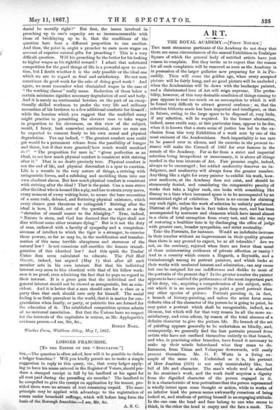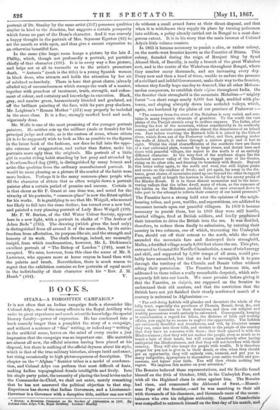ART.
THE most strenuous partizans of the Academy do not deny that there are some circumstances of the annual Exhibition in Trafalgar
Square of which the general body of untitled artists have just reason to complain. But they invite us to expect that the reason for all such complaints will be removed as soon as the Academy is in possession of the larger galleries now preparing for it in Pic- cadilly. Then will come the golden age, when every accepted picture will be fairly hung, and no good picture will be excluded ; when the Academician will lie down with the landscape painter, and a disinterested love of Art will reign supreme. The proba- bility, however, of this very desirable condition of things coming to pass appears to rest too much on an assumption to which it will be found very difficult to attract general credence ; as, that the selection hitherto made has been impartial and intelligent, or that in future, owing to the large space to be disposed of, very little, if any selection, will be required. To the former alternative, indeed, some credit may, at this particular time, appear to be due, when it is known that a stern sense of justice has led to the ex- clusion from this very Exhibition of a work sent by one of the most eminent of the Academicians. Such impartiality is too rare to be passed over in silence, and its exercise in the present in- stance will make the Council of 1867 for ever famous in the annals of the Academy. For so far from a strict and impartial selection being inexpedient or unnecessary, it is above all things needed in the true interests of Art. Fair promise ought, indeed, always to be encouraged ; but settled mediocrity deserves no in- dulgence, and mediocrity will always form the greater number. Anything like a right for every painter to exhibit his work, how- ever mediocre, at the Academy does not exist, and should be strenuously denied, and considering the comparative paucity of works that take a higher rank, one looks with something like dismay to a time when increased space is to be accompanied by an unrestricted right of exhibition. There is no excuse for claiming any such right, unless the work of selection be unfairly performed. Distrust of the judges has in fact taken deep root, and has been accompanied by murmurs and clamours which have issued almost in a claim of total exemption from every test, and the only way of restoring a healthier tone is by discharging the office of judge with greater care, broader sympathies, and strict neutrality.
Take the Portraits, for instance. Would an indefinite increase in their number without an improvement in their quality greater than there is any ground to expect, be at all tolerable ? Are we not, on the contrary, rejoiced when there are fewer than usual of those uninteresting evidences of private affection or vanity ? And in a country which counts a Hogarth, a Reynolds, and a Gainsborough among its portrait painters, and which looks at their works with unabated interest and admiration, can any cause but one be assigned for our indifference and dislike to most of the portraits of the present day? In the greater number the painter appears to have omitted the performance of the most important part of his duty, viz., acquiring a comprehension of his subject, with- out which it is no more possible to paint a good portrait than any other species of picture. Portrait painting is, in fact, a branch of history-painting, and unless the artist form some definite idea of the character of the person he is going to paint, he may paint a portrait which shall be recognizable, indeed, as a likeness, but which will for that very reason be all the more un- satisfactory, and even odious, by reason of the total absence of a definite character to give the picture life. No branch of the art of pfdAing appears generally to be undertaken so blindly, and, consequently, we generally find the best portraits proceed from artists who have not confined themselves entirely to that branch, and who, in practising other branches, have found it necessary to make up their minds beforehand what they mean to do. Instances, from Titian and Velaaquez downwards, will easily present themselves. Mr. G. F. Watts is a living ex- ample of the same rule. Unfinished as it is, his portrait of Herr Joachim (619) is not only unmistakably like, but full of life and character. The man's whole soul is absorbed in his musician's work, and the work itself acquires a dignity from the dignified character of the person engaged in it. It is a characteristic of true portraiture that the person represented is wholly intent upon some thought or action, while in works of an inferior kind the person seems awkwardly conscious of being looked at, and studious of putting himself in an engaging attitude. In the one case the head and face belong to one who seems to think, in the other the head is empty and the face a mask. The portrait of Dr. Stanley by the same artist (207) possesses qualities similar in kind to the Joachim, but suggests a certain pomposity which forms no part of the Dean's character. And it was scarcely a happy thought in the portrait of Mrs. Seymour Egerton (82) to set the mouth so wide open, and thus give a vacant expression to an otherwise beautiful face.
In the same (the large) room hangs a picture by the late J. Philip, which, though not professedly a portrait, yet partakes chiefly of that character (191). It is in every way a fine picture, and helps not at all to reconcile us to the artist's premature death. " Antonia " (such is the title) is a young Spanish woman in black dress, who attracts and holds the attention by her air of subdued melancholy. There is here that great charm (already alluded to) of unconsciousness which stamps the work of a master, together with grandeur of treatment, truth, strength, and refine- ment of colour, and certainty and knowledge in execution. Black, grey, and sombre green, harmoniously blended and gradated, set off the brilliant painting of the face, with its pure gray shadows. Mr. Leighton's "Roman Mother" (574) may properly be included in the same class. It is a fine, strongly marked head and neck, vigorously done.
Mr. Wells is one of the most promising of the younger portrait painters. He neither seta up the milliner (male or female) for his principal judge and critic, as is the custom of some, whose sitters (it is to be supposed) wish to look as like as possible to the figures in the latest book of the fashions, nor does he fall into the oppo- site extreme of exaggeration, and rather than flatter, make his portraits more ugly than the originals. His portrait of a little girl in scarlet riding habit standing by her pony and attended by a Newfoundland dog (288), is distinguished by many honest and artist-like qualities from the ordinary manufactured portrait. It would be more pleasing as a picture if the scarlet of the habit were more broken. Perhaps it is the many common-place people who fill the character of sitters that so often weighs down a portrait painter after a certain period of promise and success. Certain it is that clever as Sir F. Grant at one time was, and noted for the vivacity of his portraits, "common-place" is now the fittest epithet for his works. It is gratifying to see that Mr. 'Weigel, who seemed too likely to fall into the same decline, has turned over a new leaf, and painted a very pleasing portrait of Lady Rose Weigell (199).
Mr. F. W. Burton, of the Old Water Colour Society, appears here in a new light, with a portrait in chalks of "The Author of Adam Bede" (735). The drawing (which gives the head only) is distinguished from all around it of the same class, by its entire freedom from affectation, its purpose-like air, and the strength and honesty of its work. The chalk drawings, indeed, are unusually insipid, from which condemnation, however, Mr. L. Dickinson's excellent portrait of "The Bishop of London " (746), must be excepted. We miss, however, from this class the name of Mr. S. Lawrence, who appears more at home crayon in hand than with the palette and brush. Nevertheless, there is much reason to regret that the exhibition contains so few portraits of equal merit in the individuality of their character with his "Rev. J. M.































 Previous page
Previous page